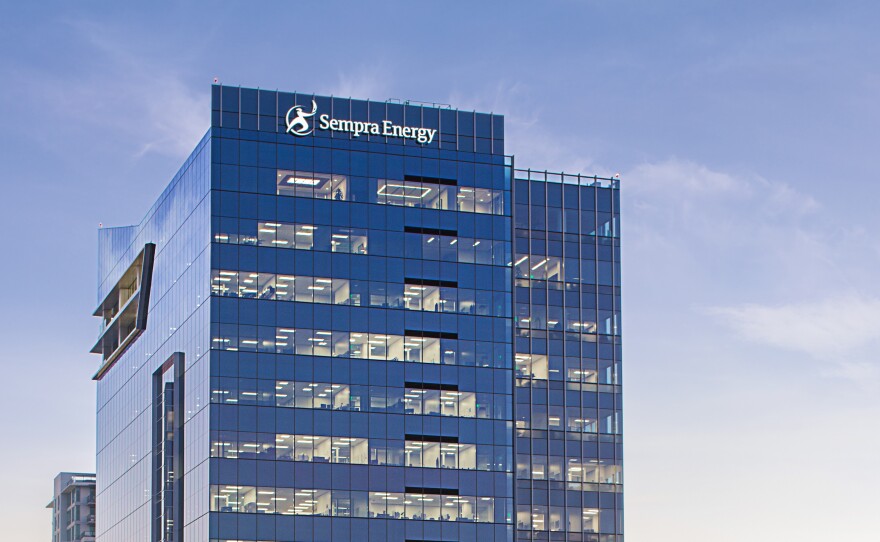Sempra Energy is backtracking on comments made by a company vice president last week that there is no technical obstacle to a 100 percent renewable grid, comments that could have been interpreted to mean fossil fuel and gas would no longer be necessary to produce electricity in California.
RELATED: Sempra Energy Executive: 100 Percent Renewable Energy Can Be Done Today
The statements by company vice president Patrick Lee caused considerable attention on social media, in part because it seemed to contradict years of argument by energy companies that going fully renewable is not yet possible. The comments could also undermine Sempra investment strategy that relied on building more natural gas-fueled plants.
In a tweet on Wednesday, Lee backtracked saying: “My conference comments were incomplete & don’t mean 100% renewable now. Today a reliable grid in CA requires natural gas-fired generation!”

The tweet came from what appeared to be a new account set up in the name of Lee, without a photo or a bio.
“But today my answer is: The technology has been resolved. How fast do you want to get to 100 percent? That can be done today,” Lee said last week.
Sempra also distanced itself from the remarks with a statement. “Lee’s comments were aspirational in nature and not reflective of Sempra Energy’s position on the issue,” it read.
The website for a Sempra spinoff company dealing with renewables was taken down following publication of the statements. Pxise Energy Solutions is commercializing new grid software and controls that allow for fast adjustments to an electrical grid that carries an increasingly dynamic flow of intermittent renewable energy. Lee is president of Pxise.
“We are working on it,” Sempra spokesman Doug Kline said of the website.
Sempra Energy owns a series of natural gas related companies. Much of its $10 billion in revenue last year came from providing gas to more than 24 million consumers. It is the parent of Southern California Gas, San Diego Gas & Electric, Sempra LNG & Midstream and Sempra Mexico, among others.
The strong response to Lee’s remarks speaks to the changes sweeping the utility industry. Renewable electricity has surged onto the grid in California. San Diego Gas & Electric provided a 43 percent renewable power mix to customers last year. Still, many residents want more. Los Angeles recently voted to create a public utility alternative to its electrical provider, Southern California Edison, in part to gain access to even higher percentages of low carbon power. Other challenges include flat demand in some places. Batteries are beginning to obviate the need for new gas plants.
On Thursday, speaking at the UCSD Institute of the Americas energy conference, Lee said, “I am speaking with confidence now. We have a solution now to adjust the intermittency of solar and wind energy that is no longer a technology challenge. Now it is an economic decision. So installing a base load power plant is no longer your only option. You can now look at solar, wind and storage as alternatives, and still be able to manage the reliability of the grid.”
Responses to Lee’s comments fell roughly into two camps. There were those who have long advocated for a faster switch and saw them as overdue.
“The content was not surprising. The messenger was,” said Evan Gillespie, director of the Sierra Club My Generation campaign, which focuses on 100 percent clean energy. “Yet they refuse to let clean energy compete and instead they build a 500-megawatt gas-fired power plant,” referring to a new power station in Carlsbad being built by NRG.
Others thought Lee was referring to the immediate ups and downs of electrical power, rather than the installed hardware that serves the grid season after season.
“Even if we accept it as true that Sempra’s team has developed a system that can manage moment by moment changes on a high-renewables grid,” said Katrina Westerhof, an analyst with technology consultant Lux Research in Boston. “If you were somehow able to flip a switch and convert all fossil fuel electricity into renewables, that is not to say that we would have a secure and reliable grid. We definitely wouldn’t.”
It was a point several experts made.
Making instantaneous fine tune adjustments are crucial, and Patrick Lee was right about that, said Christopher Clack, CEO of Vibrant Clean Energy. “But that’s only the short-term variability.”
The first 80 percent renewable energy is easy, he said. “The last 20 percent is very difficult because of these longer-term events, where you could lose solar or wind for three to five days.” It is not possible to store that much energy economically today.
Devin Hartman, electric policy manager at the free market R Street Institute, said California frequently has to ratchet back on solar entering the system, effectively wasting that clean energy. To avoid that, you would need “massive” amounts of batteries to store it.
Everyone agrees the cost of storage is dropping, but it is “not close to affordable,” he said. Many things are possible technically, but to run a system that relies heavily on storage today, “I can’t begin to tell you what the cost would be over the entire Eastern interconnect.”






